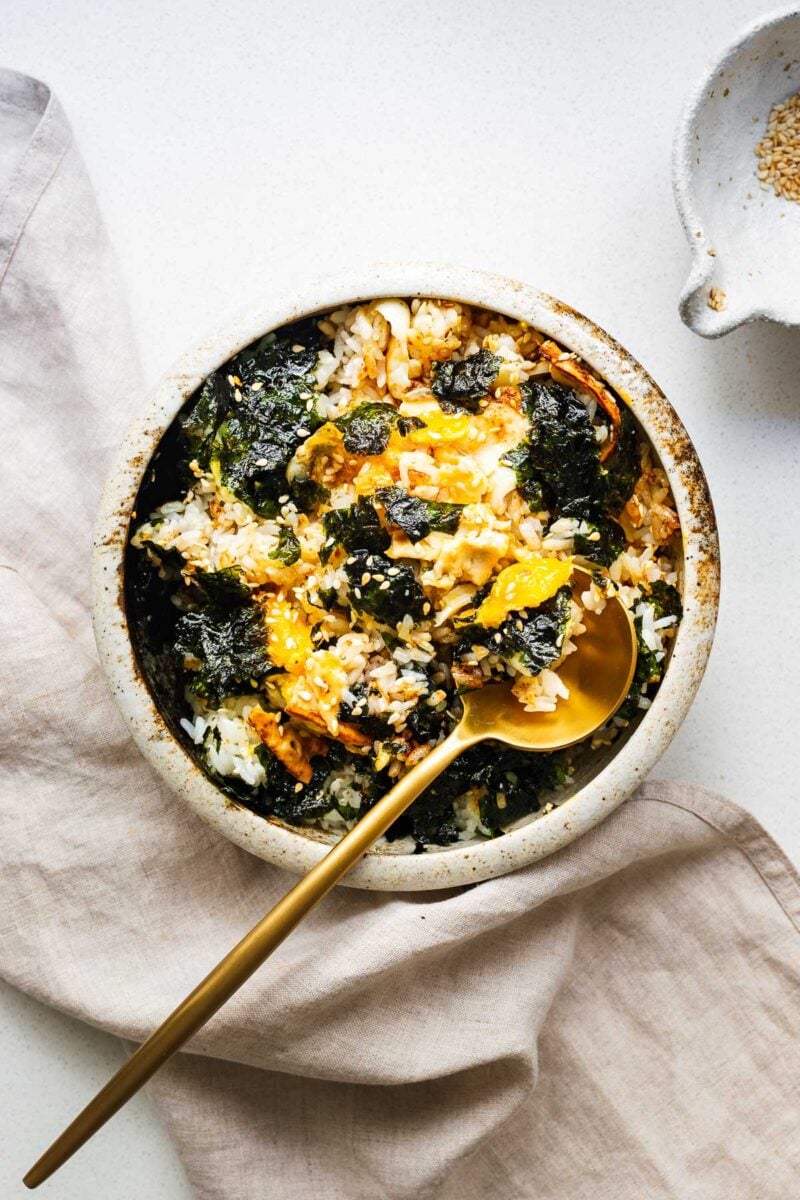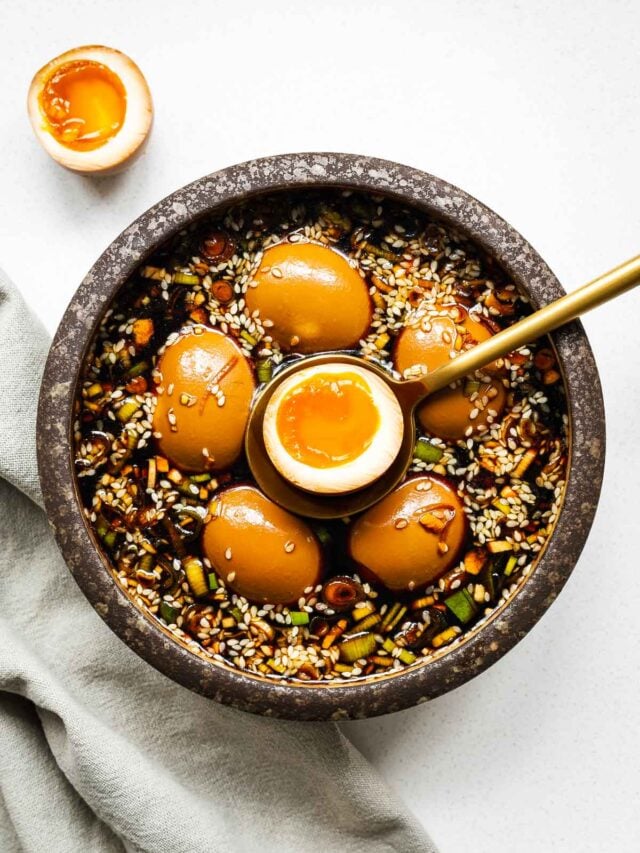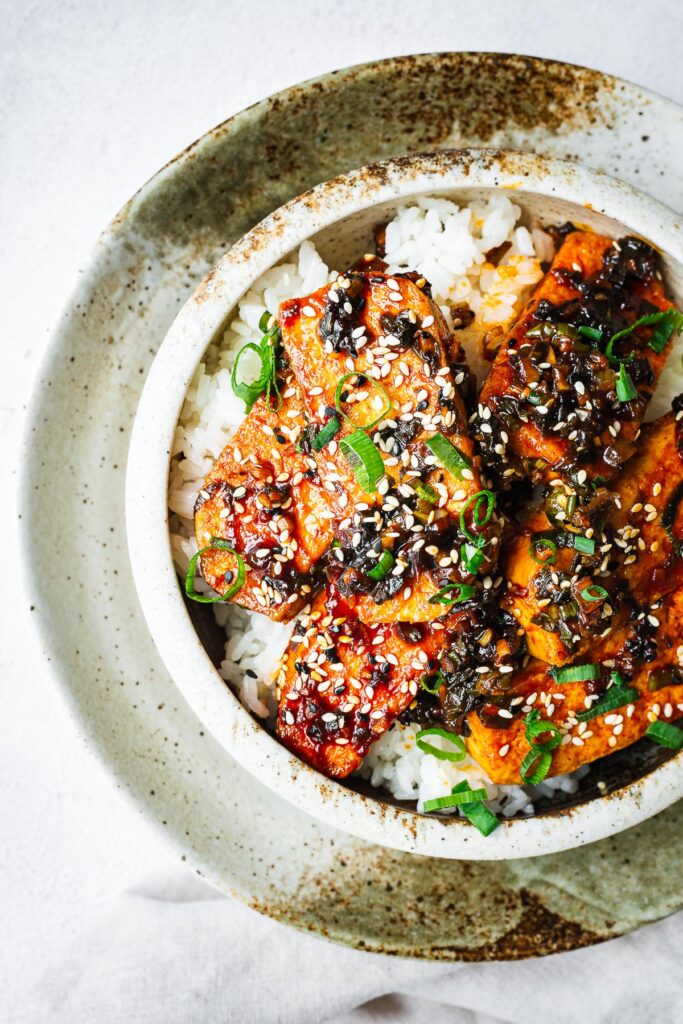Korean Soft Tofu Stew (Sundubu Jjigae)
This popular Korean soft tofu stew is made with soft silken tofu, zucchini, and a flavourful broth spiced with gochugaru. It’s a quick and easy dish perfect for cold winter days. But it’s so good, I make it in summer too!
Warm up your winter nights with a steaming bowl of Korean soft tofu stew (sundubu jjigae). This spicy and comforting dish is a staple in Korean cuisine and is perfect for cold days served alongside a bowl of steamed white rice.
And it’s easy to see why. The recipe is customisable, ready in only 25 minutes, and it’s so irresistibly delicious I make it almost every week.
The silky soft tofu, zucchini, and mushrooms cook in a flavorful broth spiced with gochugaru (Korean red pepper flakes). I also like to pop an egg in right at the end (which you can simply omit for a vegan tofu stew). And, I provide instructions for a meatier version too.
So, grab your tofu and get ready to enjoy a taste of Korea with this delicious sundubu jjigae recipe.

Why you’ll love this recipe
Sundubu jjigae is a classic Korean dish loved by locals and visitors alike.
- Customisable recipe: You can play around with different ingredients like pork belly or shiitake mushrooms to suit your taste preferences. Or opt for a vegan version. Transform it into soft tofu soup by adding an extra cup of broth.
- Quick and easy meal: This dish can be made in just 25 minutes, making it perfect for a busy weeknight.
- Flavour-packed: With gochugaru (Korean chilli flakes) and other spices, this stew packs a spicy flavour that’s both wholesome and comforting.
- Vegan-friendly: Simply use vegetable broth and omit the eggs for a vegan sundubu jjigae. The dish is also naturally gluten-free.
Ingredients and substitutes










This Korean stew is a comforting and flavourful dish, perfect for a chilly day. Luckily, it’s also a very flexible recipe.
- Zucchini: I like to use young zucchini or baby courgettes for this dish, but a large zucchini will also work. You can also substitute with any other type of squash or pumpkin.
- Oil: I use a combination of toasted sesame oil and vegetable oil, but you can use only the one you have.
- Aromatics: The broth is flavoured with the magical combination of garlic, onion and ginger.
- Gochugaru: This is a Korean red pepper flake, which adds heat, depth of flavour, and a beautiful red colour to the stew. If you can’t find gochugaru, you can use any other red chilli flake.
- Stock: While traditional Korean anchovy stock is often used in this dish, you can also use dashi, chicken stock, vegetable stock, or even just water. Use a stock that you love for the best results. You can even double the amount of stock for a Korean tofu soup.
- Soy sauce: I use light soy sauce, but all-purpose soy sauce is perfect too.
- Mirin: I used Japanese hon mirin, which is more complex and less sweet than some commercial mirin brands. If you don’t have mirin, simply add a pinch of sugar for sweetness.
- Ground white pepper: Nothing adds an authentic flavour boost quite like white pepper powder, but you can opt for freshly ground black pepper too.
- Silken tofu: This type of tofu has a silky smooth texture that melts in your mouth, similar to custard. If you can get it, use a tube of Korean soondubu (Korean soft tofu), otherwise use a fresh silken tofu (available in the refrigerated section of the grocery store) – see the brand I use in the images above.
- Enoki mushrooms: These delicate mushrooms add a subtle earthy flavour to the stew. You can also use shimeji mushrooms. Or, if you prefer, use sliced shiitake mushrooms or king oyster mushrooms, just add them with the onions as they’ll need longer to cook.
To serve (optional)



- Eggs: Adding whole eggs or just egg yolks at the end of cooking is optional, but it adds a rich and creamy element to the stew. Steam the eggs in the stew for a moment, or simply pop a raw egg yolk in when serving. You can also omit the eggs for a vegan version.
- Green chilli: For that second spicy kick. Omit if you don’t want the tofu stew to be too spicy.
- Green onion: Chopped green onions add freshness to the final stew.
Optional variations
- Meat: For a protein boost, add ground meat or pork belly. Cook the meat in the oil until brown before you add the onions, garlic, and ginger. Continue with the recipe as written.
- Kimchi: For a delicious kimchi stew (kimchi jjigae), stir some shredded kimchi into the soup for the last minute of cooking to heat through.

Frequently asked questions

Serving suggestions
Traditionally, sundubu jjigae is made and served in a Korean earthenware pot called a ttukbaegi. The stew looks beautiful dished up straight from the clay pot. But, if you don’t have one, simply divide the stew into serving bowls, carefully scooping an egg into each (if you’re using it).
Then serve with steamed white rice (preferably medium- or short-grain rice).
See how to cook Instant pot short-grain rice or stovetop sushi rice. Just omit the sushi vinegar and serve your perfectly fluffy steamed white rice alongside the spicy tofu stew.
And, finally, select a range of Korean side dishes (banchan). Some of my favourites include:
- Kimchi: The undeniable king of banchan. Look for a brand without fish sauce or shrimp paste if you need vegan kimchi.
- Oi muchim: A quick and easy, spicy Korean cucumber salad.
- Pa muchim: Swap the sliced green onions for a green onion salad.
- Gamja jorim: Soy-braised potatoes served hot or cold.
More Korean recipes you may like
If you like this lemon tahini sauce, you might also like these tahini dressings and sauces

Ingredients
- 10 ounces zucchini* (about 1 large or 3 baby ones)
- fine sea salt
- 1 tablespoon vegetable oil
- 1 tablespoon toasted sesame oil
- ½ onion , thinly sliced
- 3 garlic cloves , minced
- ½ teaspoon grated ginger root
- 1 tablespoon gochugaru (Korean red pepper flakes) , or another red chilli flake
- 1½ cups stock* , use chicken, vegetable, or dashi
- 1 tablespoon light soy sauce , or more to taste
- 1 tablespoon mirin , or a tiny pinch of sugar
- ¼ teaspoon white pepper
- 1 10½ ounce pack soft silken tofu
- 3½ ounces enoki mushrooms
To finish (optional)
- 2 eggs , whole or just yolks
- 1 green finger chilli , chopped
- 1 green onion (scallion) , thinly sliced
Instructions
- Cut the zucchini (courgette) into bite-sized chunks – I like to quarter a large zucchini or half a baby zucchini before slicing it into smaller pieces. Sprinkle with a pinch of sea salt and set aside.
- Place a heavy-based saucepan on medium heat. Add the oil, sliced onion, minced garlic and grated ginger, with a good pinch of salt. Sauté gently, stirring occasionally, until the onions are softened a little and it starts to smell fragrant – about 5 minutes. Add the gochugaru and stir constantly for a minute without letting it burn – the flakes will bloom and turn everything a beautiful bright red, but they burn easily.
- Pour in the stock, then stir in the soy sauce, mirin, and white pepper. Add the zucchini and soft tofu. Roughly break the tofu up with a spoon and increase the heat to bring to a boil. Once it starts to bubble, reduce the heat to medium and cook until the courgettes are tender – about 10 minutes. Taste and adjust the seasoning with salt – I add about 1 teaspoon of salt.
- Scatter with the enoki mushrooms and gently crack in the eggs, if using. Sprinkle with the green chilli, if using (taste the stew for spiciness before adding the chilli). Cover with a lid to steam the eggs for 2 minutes, or until cooked to your liking.
- Divide the Korean spicy soft tofu stew between bowls, carefully scooping each egg into a bowl. Sprinkle with green onions and serve hot, with steamed rice.
Notes
- Stock: The traditional choice would be to use Korean anchovy stock, but dashi also works well. Though I most often make this with homemade vegetable or chicken stock, you can also use water. If you use a stock you love, you’ll love the stew too!
- Zucchini: I prefer to use young zucchini (baby courgettes or baby marrows), but a large zucchini works fine too.
- Vegan Sundubu: Omit the optional eggs and use vegan dashi or vegetable stock.
- Meat: If you want to, you can stir-fry 3½ ounces (100 grams) of ground pork in the oil until golden brown (about 5 minutes) before you add the onion, garlic, and ginger.





I love tofu stews, and this one is next level! Fantastic instructions, too. Thanks!
I’m so happy you enjoyed it, Mahy!
This looks amazing and such a treat, I love tofu stew! I can’t wait to try your recipe!
You really should! It’s such a great dish! 🤤
Let me know how your cooking went! I really hope you love this Korean soft tofu stew recipe as much as I do. 🥰